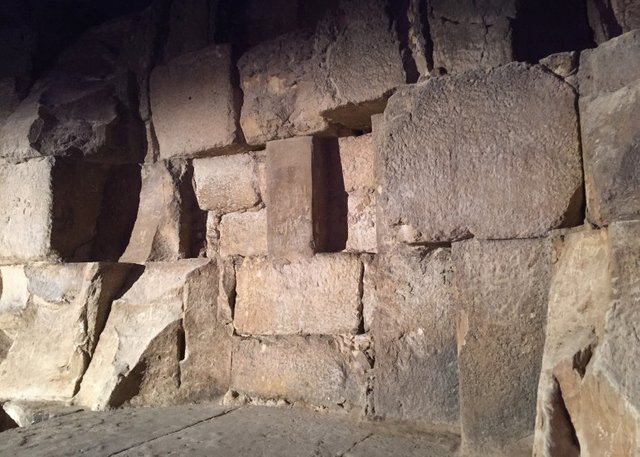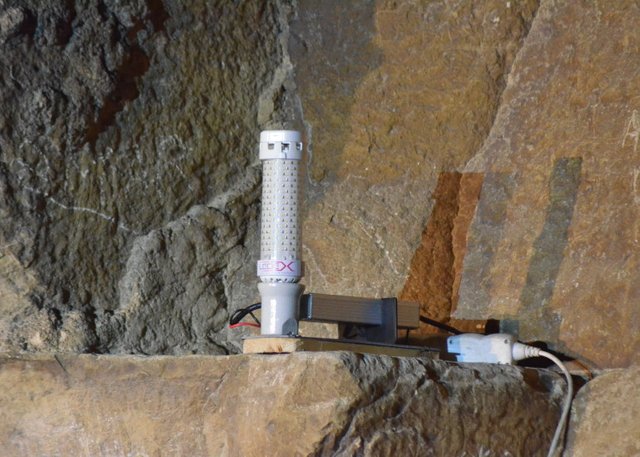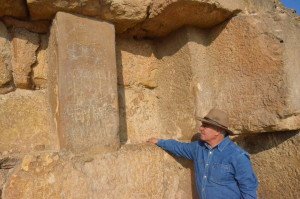
The Ministry of Antiquities announced important discoveries at a recent press conference, held on the eastern side of the Great Pyramid of Khufu on the Giza Plateau. It followed release of the preliminary results of the Scan Pyramids project. The project hopes to discover the secrets of the Pyramid of Khufu, including whether or not there are hidden rooms or tunnels.
The conference was attended by Minister of Antiquities Mamdouh Eldamaty and Hany Helal, the project’s general coordinator. The project is being carried out through cooperation between the Ministry of Antiquities, the Faculty of Engineering at Cairo University and the French Heritage, Innovation and Preservation (HIP) Institute.
The project team announced that it had found an anomaly in the temperature of three blocks at the base of the eastern side of the pyramid, facing the solar boat pit. Speculation was that that these three blocks hid a secret behind them, such as a hidden room or previoulsy unknown tunnel.
Using infrared thermography, the team noticed that the three blocks on the eastern side of the pyramid registered a higher temperature in comparison with the adjacent stones. These measurements, made at different times of day, showed the higher temperature of these blocks by about four to five degrees. The team announced that the results had been provided to archaeologists and Egyptologists for evaluation and were currently under review.

Since I was not invited to the conference to give my opinion on these readings as a specialist on pyramids, and as there was no scholar specialising in pyramids present, I see it as my duty as an archaeologist to give my opinion.
It is not my intention to attack anyone or to disagree just for the sake of doing so, but history one day will write about these discoveries and the different opinions that have emerged must be recorded.
I would have hoped that, before the announcement of any discoveries, a group of scientists and Egyptologists specialising in pyramids would have been formed to study the results of the measurements. This would have contributed significantly to their validation.
Hany Helal, the project coordinator, said that the pyramids were built by engineers, perhaps suggesting that, because of this, engineers would understand pyramids better than anyone else. This would be true if we asked an architect or engineer about the architectural components of a pyramid, but when it comes to the secrets of the Pyramids at Giza, these are known only to Egyptologists, and not to engineers.
There is also a need to comment on some of the advanced technologies used in this project; in particular, muon detection and infrared thermography. Muons are atmospheric particles deriving from the collision of cosmic rays and the nuclei of atoms in the upper strata of the atmosphere.
Cosmic-ray detection has been used before on the Pyramid of Khafre. This was when Berkeley University and Ain Shams University carried out a project to study the second Pyramid at Giza in 1965.
When the project was approved in June 1966, the team entered a chamber inside the pyramid, known as the “Belzoni Room”, and also worked inside the Pyramid of Khufu. It was announced to the press and the scientific community that they had found rooms and tunnels. However, no Egyptologists considered these results to be valid.
People connected with the Electricity Authority in France have also worked inside the Khufu Pyramid and dug holes in the western wall of the tunnel leading to the second chamber, incorrectly referred to as the “Queen’s Chamber.” They announced the discovery of sand while digging the hole and indicated that the presence of sand proved the existence of unknown rooms inside the pyramid.
Following this announcement, however, they were not permitted to continue working inside the pyramid because they had published a magazine article under the title “We are the ones who dug holes in the Pyramid.”
Later, a Japanese team used other techniques, with newer equipment, inside and outside Khufu’s Pyramid and announced the existence of a huge tunnel on the south side of the Great Pyramid.
At the beginning of the 2000s, French architect Jean-Pierre Houdin published a book on his father’s theory that the Great Pyramid was built using internal ramps rather than external ramps, as many Egyptologists believe. I think that Houdin is now a member of the team working on the Scan Pyramids project.
Abdel-Halim Noureldin, head of antiquities in Egypt at the time, allowed a French person not associated with any institution to make holes on the floor of the first burial chamber inside Khufu’s Pyramid, and also outside the entrance of this room.
Scientists at Giza at the time, of whom I was one, objected to the work of this person and asked him to leave the Giza Plateau. But the following day, Noureldin arrived from Paris and signed a decree to let this person dig a hole in the pyramid.
Egyptologists and scientists agree that the use of new technology is very important and is perhaps necessary to discover the secrets of the pyramids. However, at the same time we must be very careful when we listen to the opinions of the scientists using this technology.
It is very important that the readings that emerge are first studied and reviewed by well-known Egyptologists who study the pyramids and have recognised, peer-reviewed publications on this topic.
I should also add that news has emerged that the permanent committee of the Ministry of Culture has approved the use of these new technologies on the Pyramid of Sneferu at Dahshur, the results of which will be submitted to the committee. Based on the outcome, the project team will be given or refused a permit to work inside the Great Pyramid.
I am quite sure that the permanent committee did not allow this group to work inside the Great Pyramid. This point should be explained, because everyone should know that the permanent committee is the only institution that can give permission to any scientist or team, who must also be connected with a scientific institution, to work on Egypt’s antiquities. The head of the Supreme Council, or even the Minister of Antiquities himself, cannot give this permission.
Blocks at Giza
I have been to the Giza Plateau to look at the blocks in question and found that there was a large vertical stone and, to the right, another stone that is divided into two parts. Looking at these two parts, it can be seen that the stones are fragile. At the top of the vertical stone is another one, also divided into two pieces.
The surface of the east side of the Pyramid of Khufu was once covered with stone rubble and sand. Jean-Philippe Laure and Abdel-Salam Hussein were among those who cleared the surface of the east side.
After this process was completed, all the stones were shown clearly and it could be noticed that there were fragile stones on the east and south side of the pyramid. Among these fragile stones, were the four pieces that flanked the vertical big stone that were highlighted by the infrared thermography analysis shown at the press conference.
The modern restorer placed this vertical stone to support the four fragile stones and used cement in the restoration. Anyone can see that this stone is not similar to the stones used in the construction of the Great Pyramid. We know that all the stones for the building came from quarries on the Giza Plateau, and the location of the quarry that provided the building material was to the south of the Pyramid and to the east of Khafre’s Pyramid.
8_DSC_8889
It is important to note that the ancient Egyptians always built subsidiary pyramids for queens to the south side of the king’s pyramid in the Old Kingdom. But Khufu’s architect found that all the stones for building the pyramid would need to come from the south, so he moved the queen’s pyramid to the eastern side, leaving the southern side, in the time of Khufu, free. We now date the boats to the reign of his son Djedefre and the tombs to the south to the reign of Khafre.
The restorers at the Giza Plateau used cement in the restoration of the vertical stone and it is easy to distinguish between the modern and ancient mortar. Mamdouh Eldamaty said at the conference that a passage had been cut in the rock located directly in front of the three stones, but this is not a passage or a tunnel. Rather, it is a natural crack in the rock that can be seen by the naked eye.
There is another important point that many people do not know about. The base of the Great Pyramid is cut some eight metres into the rock, and this can be seen clearly on the south side of the pyramid. It would be impossible to see a room or tunnel in this location near to the rock.
If this room exists, it would have to have a function, and since this is not the case the claim cannot be valid. Perhaps the announcement was made to prove the theory of Houdin regarding the existence of internal ramps inside the pyramid.
The modern technology that has been used on the pyramids until today has never given Egyptologists correct results. I would like to ask my friend Hany Helal to show us the results or readings of his machines so they can be discussed before any announcement is made. The recent press conference did not show any actual results.
In my opinion, the Pyramid of Khufu still holds many secrets. I believe that the most important project, which brought significant discoveries, was when we tried to decrease the levels of humidity inside the pyramid. The project involved Rainer Stadelmann, an expert on pyramids, who suggested that a robot be used to clean the tunnels wrongly known as ventilation tunnels.
When a robot was sent inside the tunnels of the King’s Chamber, it could be seen how the stones interlocked. I said to myself that the ancient Arab writers had been right when they came to Egypt in the 9th century and said, “Man fears time and time fears pyramids.”
The robot was called Web-wawaat, the name of an ancient Egyptian god that means “the Opener of the Road.” The robot entered the northern tunnel, starting from the second chamber, moved forward about 20 metres, and found that the tunnel was not straight but turned. It was then positioned in the south tunnel and moved forward for about 60 metres before stopping in front of a so-called “secret door” bearing two copper handles (20 x 20 cm).
When I was chosen as explorer-in-residence for the magazine National Geographic, I asked for a robot called Pyramid Rover to be designed. Using this robot, we cut a hole in the stone in the south tunnel of about 1 cm x 1 mm.
21 cm away from the first stone, the camera on the robot showed a second stone without copper handles. Then we sent the robot to the northern tunnel and found that after 20 metres it bent north and then south for 8 metres to avoid the Grand Gallery in the Pyramid. The robot continued for 60 metres, just as it had in the south tunnel, and stopped in front of a third door with two copper handles.
A similar project was recently proposed by a British university. The project proposes to use a robot called Djedi to discover what is behind these stones.
Hidden mysteries
Khufu’s Pyramid, and the king himself, still hides lots of mysteries. Recently, an important discovery was made that has not been previously announced. This was the discovery of the oldest papyrus in Egypt, found in a port on the Red Sea.
The papyrus says that “Mrrw”, one of the overseers of a group of workmen, went there.
It says that they cut fine white limestone from Turah, and after going to Sinai for copper they came to the port in the 27th year of Khufu’s reign. They worked under the architect Ankh-Kaf and then went back to the area of Giza called R-she (“Mouth of the Lake”), taking one day to reach the top of the pyramid.
This papyrus reveals many important things. The group of workmen reached the port in the 27th year of Khufu’s reign, providing evidence that could end the assumption that the reign of Khufu lasted 23 years, based on the Turin Papyrus.
We can say with certainty, based on this discovery, that Khufu ruled for 32 years, because we know that the ancient Egyptians counted the reign of a king according to the number of cattle every two years. However, in Sneferu’s reign this count happened every year, meaning we have to be very careful when calculating the reign of the king.
It had also been thought that Hem-Iuno was the architect who built the Great Pyramid, but now we can say that he died during its construction and that Ankh-Kaf completed the work and built the Second Pyramid. I believe that the location of R-she is Abusir.
